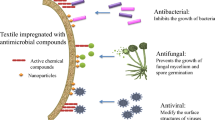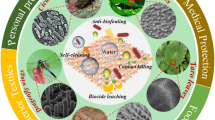Abstract
This study aimed to develop UV-curable coating materials showing antimicrobial properties. GTAC was acrylated and characterized by FT-IR and 1H NMR spectroscopy. UV-curable coating materials with different contents were prepared. Inhibition zone method was used to determine the antimicrobial activity of the materials. Thermal stability of samples was evaluated by TGA. Contact angles of samples were measured to obtain information about their hydrophobicity. Surface morphology of samples was investigated by SEM. Produced UV-curable coating materials have good antimicrobial, thermal and surface properties, and they can be used as antibacterial top coating material in many industries.






Similar content being viewed by others
References
Edge M, Allen NS, Turner D, Robinson J, Seal K (2001) The enhanced performance of biocidal additives in paints and coatings. Prog Org Coat 43:10–17. https://doi.org/10.1016/S0300-9440(01)00244-2
Ahonen M, Kahru A, Ivask A, Kasemets K, Kõljalg S, Mantecca P, Vinković Vrček I, Keinänen-Toivola MM, Crijns F (2017) Proactive approach for safe use of antimicrobial coatings in healthcare settings: opinion of the COST action network AMiCI. Int J Environ Res Public Health 14:366–388. https://doi.org/10.3390/ijerph14040366
Adlhart C, Verran J, Azevedo NF, Olmez H, Keinänen-Toivola MM, Gouveia I, Melo LF, Crijns F (2018) Surface modifications for antimicrobial effects in the healthcare setting: a critical overview. J Hosp Infect 99:239–249. https://doi.org/10.1016/j.jhin.2018.01.018
Morones JR, Elechiguerra JL, Camacho A, Holt K, Kouri JB, Ramírez JT, Yacaman MJ (2005) The bactericidal effect of silver nanoparticles. Nanotechnology 60:69–72. https://doi.org/10.1088/0957-4484/16/10/059
Kim JS, Kuk E, Yu KN, Kim JH, Park SJ, Lee HJ, Kim SH, Park YK, Park YH, Hwang CY, Kim YK, Lee YS, Leong DH, Cho MH (2007) Antimicrobial effects of silver nanoparticles. Nanomed Nanotechnol Biol Med 3:95–101. https://doi.org/10.1016/j.nano.2006.12.001
Rai M, Yadav A, Gade A (2008) Silver nanoparticles as a new generation of antimicrobials. Biotechnol Adv 27:76–83. https://doi.org/10.1016/j.biotechadv.2008.09.002
Wernicki A, Puchalski A, Urban-Chmiel R, Dec M, Stęgierska D, Dudzic A, Wójcik A (2014) Antimicrobial properties of gold, silver, copper and platinum nanoparticles against selected microorganisms isolated from cases of mastitis in cattle. Med Weter 70:564–567
Ocakoĝlu M, Şen F, Kahraman MV (2017) Synthesis of B/P/N containing flame-retardant additives and UV curable hybrid coating applications. Adv Polym Technol 36:517–524. https://doi.org/10.1002/adv.21638
Jeong KM, Park SS, Nagappan S, Min G, Zhang Y, Qu M, Zhang Y, Ha CS (2019) Highly transparent, organic-inorganic hybrid UV-curable coating materials with amphiphobic characteristics. Prog Org Coat 134:323–332. https://doi.org/10.1016/j.porgcoat.2019.05.029
Choi WC, Lee WK, Ha CS (2019) Low-viscosity UV-curable polyurethane acrylates containing dendritic acrylates for coating metal sheets. Coat Technol Res 16:377–385. https://doi.org/10.1007/s11998-018-0117-9
Banerjee SL, Potluri P, Singha NK (2019) Antimicrobial cotton fibre coated with UV cured colloidal natural rubber latex: a sustainable material. Colloid Surface A 566:176–187. https://doi.org/10.1016/j.colsurfa.2019.01.018
Rashid AKA, Younas R, Chong R (2016) A chemical reduction approach to the synthesis of copper nanoparticles. Int Nano Lett 6:21–26. https://doi.org/10.1007/s40089-015-0163-6
Toker RD, Kayaman-Apohan N, Kahraman MV (2013) UV curable nano-silver containing polyurethane based organic-inorganic hybrid coatings. Prog Org Coat 76:1243–1250. https://doi.org/10.1016/j.porgcoat.2013.03.023
Bayramoglu G, Kahraman MV, Kayaman-Apohan N, Güngor A (2006) Synthesis and characterization of uv-curable dual hybrid oligomers based on epoxy acrylate containing pendant alkoxysilane groups. Prog Org Coat 57:50–55. https://doi.org/10.1016/j.porgcoat.2006.06.002
Şen F, Uzunsoy İ, Baştürk E, Kahraman MV (2017) Antimicrobial agent-free hybrid cationic starch/sodium alginate polyelectrolyte films for food packaging materials. Carbohydr Polym 170:264–270. https://doi.org/10.1016/j.carbpol.2017.04.079
Gao Q, Li H, Zeng X (2011) Preparation and characterization of UV-curable hyperbranched polyurethane acrylate. J Coat Technol Res 8:61–66. https://doi.org/10.1007/s11998-010-9285-y
Ramos-Lara F, Lira A, Ramirez M, Flores M, Arroyo R, Caldiño U (2006) Optical spectroscopy of Nd3+ ions in poly(acrylic acid). J Phys Condens Matter 18:7951–7959. https://doi.org/10.1088/0953-8984/18/34/008
Goldberg S, Doyle R, Rosenberg M (1990) Mechanism of enhancement of microbial cell hydrophobicity by cationic polymers. J Bacteriol 172:5650–5654. https://doi.org/10.1128/jb.172.10.5650-5654.1990
Lemire JA, Harrison JJ, Turner RJ (2013) Antimicrobial activity of metals: mechanisms, molecular targets and applications. Nat Rev Microbiol 11:371–384. https://doi.org/10.1038/nrmicro3028
Madakbaş S, Şen F, Kahraman MV, Dumludağ F (2014) Preparation, characterization, thermal, and dielectric properties of polypyrrole/h-BN nanocomposites. Adv Polym Technol 34:21438. https://doi.org/10.1002/adv.21438
Acknowledgements
This work was supported by Marmara University, Commission of Scientific Research Project under the project FEN-B-170118-0010.
Author information
Authors and Affiliations
Corresponding author
Additional information
Publisher's Note
Springer Nature remains neutral with regard to jurisdictional claims in published maps and institutional affiliations.
Electronic supplementary material
Below is the link to the electronic supplementary material.
Rights and permissions
About this article
Cite this article
Birtane, H., Şen, F., Bozdağ, B. et al. Antibacterial UV-photocured acrylic coatings containing quaternary ammonium salt. Polym. Bull. 78, 3577–3588 (2021). https://doi.org/10.1007/s00289-020-03287-0
Received:
Revised:
Accepted:
Published:
Issue Date:
DOI: https://doi.org/10.1007/s00289-020-03287-0




